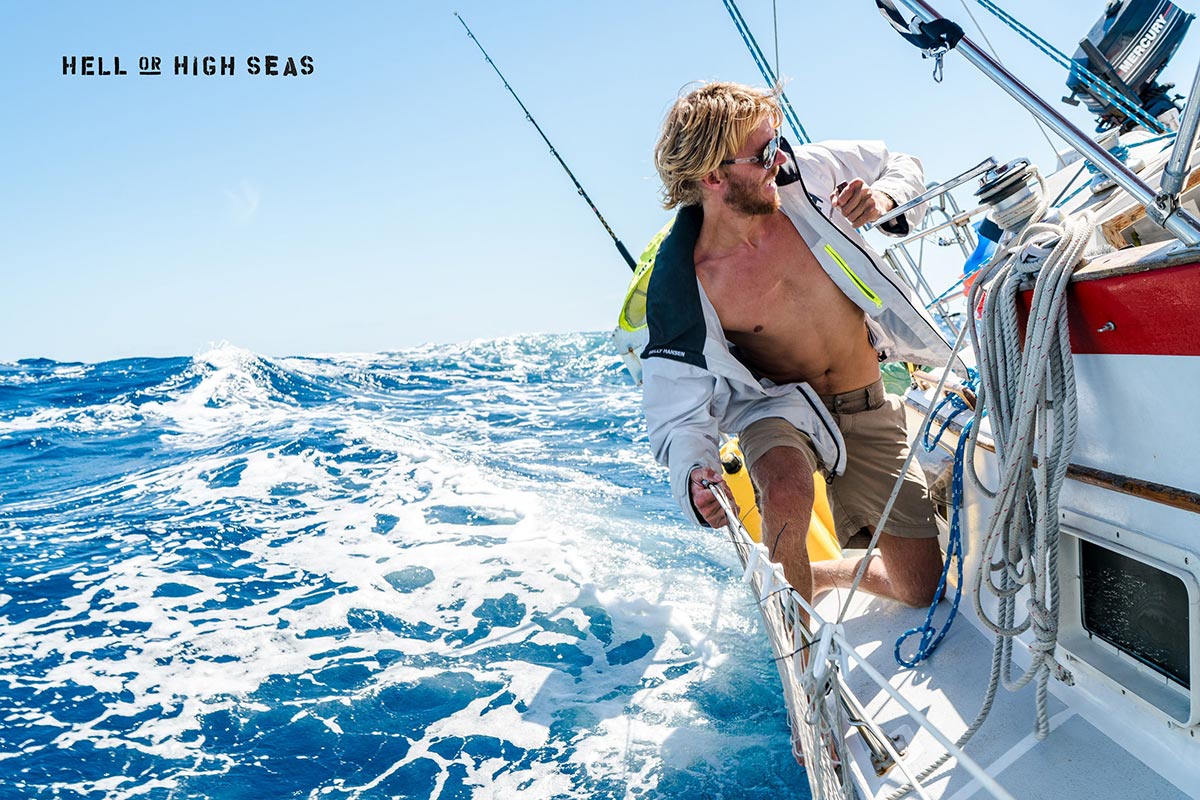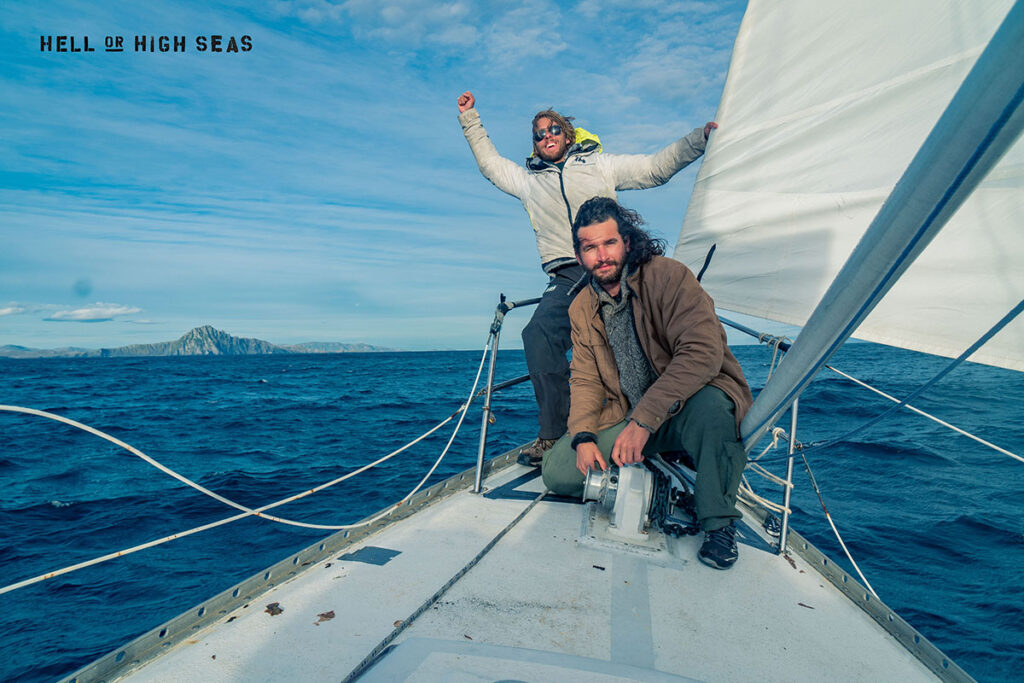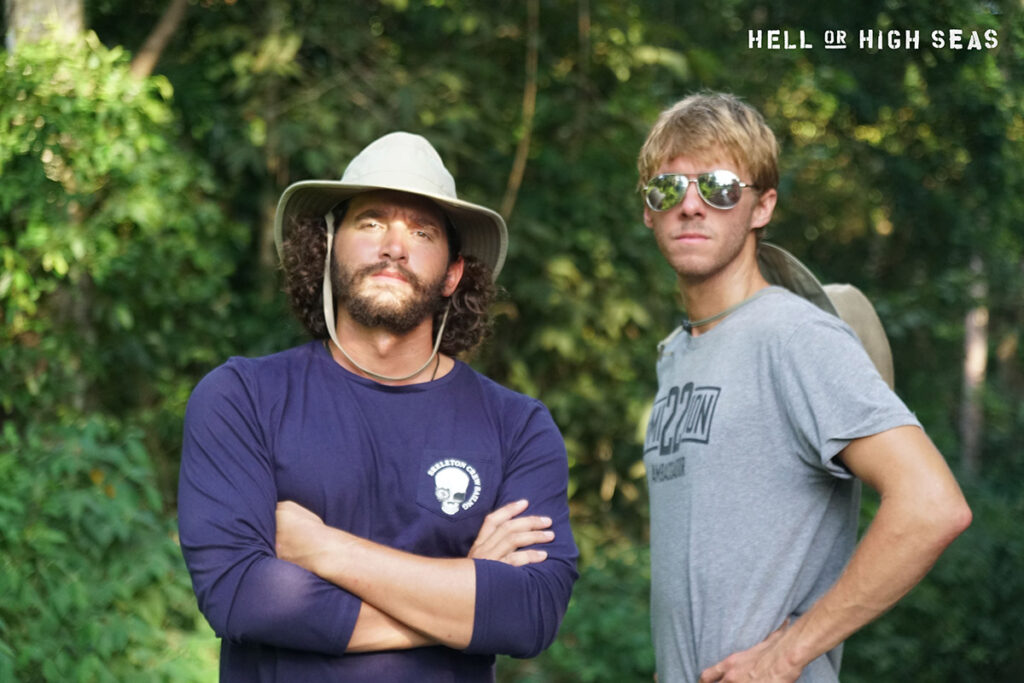
To Hell and Back: Filmmaker Stephen O’Shea Shines A Light On The Dark Truth About America’s Veterans
There’s walking the walk, then there’s what Stephen O’Shea did. He put his life on the line to tell a story that mattered. Here, the documentarian reveals what he hopes to accomplish with Hell or High Seas—and why making the film was even more difficult than it appeared.
Interview by Matt Tuthill
RI Magazine: There was incredible danger in this project. You do a good job of focusing on Taylor and the danger he’s in because it’s his decision and his story. But what about you? You’re holding the camera, not at all removed from the danger. What made you want to do this?
Stephen O’Shea: I think my elevator response is that we were naive to a lot of the dangers that we were going to face. Crossing the Gulf of Mexico, I thought we’d have a better gauge of what the weather would be. The Caribbean itself ended up being pretty destructive. And then I was just naive to sailing in general. I’d never really done an overnight sail before that trip.
But I was aware there were going to be some major risks involved and I think deep at the root, it really ties back to a lot of research that I began toward the end of my undergraduate career, which involves interviewing combat veterans from Iraq and Afghanistan.
In that research, we talk a lot about survivors’ guilt, and I came to realize that there’s something akin to it that is more like civilians’ guilt, because especially at that time, a lot of the guys and women that we were interviewing were my peers, they were my same age and Taylor is a perfect example. He went into the Navy right out of high school. Hearing about a lot of the shit he’d been through was pretty jarring. It felt like I needed to do more, even as I was writing my first book From The Land of Genesis, which is all based on those interviews, it still felt like I wasn’t doing enough. And this sailing trip jumped out as an opportunity, not necessarily for me to put my life on the line, but certainly to do something in a way that could make a powerful impact.
RI: There’s a moment in the film where Taylor talks about the veteran suicide crisis and says society keeps asking how can we help these people who are in so much pain and stop them from taking their own lives? But he asks, “Well, what if we acted before then?” But human beings are terrible at taking preventative measures. We deal with the thing that is blowing up in front of us and rarely try to defuse the bombs down the road. So what do you hope to ultimately accomplish with this film?
SO: Right now, I’m working with the Texas forest service on a lot of different things like fire wildfire prevention and mitigation, and it’s the same uphill battle, right? Nobody wants to put money and effort towards preventative measures, but you can save a lot of time, a lot of money, and a lot of lives by doing that. So for the people that that message that doesn’t really resonate at the very least, I hope that this documentary reaches other veterans and lets them know that they’re not alone in their experiences. And for the active duty guys, I hope that it helps prepare them for what’s to come. A lot of what we focus on in the documentary is the physiological response to chronic stress and PTSD.
A lot of guys in the military aren’t even educated about that. PTSD wasn’t even mentioned to Taylor as he was being out processed. And whether that’s a problem we can fix within the military, or it’s something that we have to confront as the general public and as civilians is hard to say, but definitely this film is meant to be a grassroots movement. It’s meant to reach veterans and civilians alike, to educate them, not only on what’s going on mentally, physically, physiologically, and emotionally, but on a on a broader spectrum.
RI: We have a tendency to think of it as guys reliving these horrible experiences and certainly that happens. But more often it’s what you show: these soldiers live at this heightened level of awareness and alertness and they’re ready to kill or be killed at a moment’s notice for this extended period of time. Then they come home and these parts of their brain are still at that heightened level of alertness. It would seem to me that you don’t have to necessarily work through the memories of each individual, but develop some kind of protocol to wean someone down from the overproduction of adrenaline.
SO: You would certainly think that there should be a pretty straightforward response to this issue. And that was a huge part of my PhD because when I first started this research, a lot of what the media and other researchers were looking into was that romanticized idea of PTSD where you’re having nightmares of the same moment over and over again. And then you would just need to go to a psychoanalyst and have them relive that moment with you, right? Until you can create a story that makes sense. But on the ground floor, what we were seeing more often than not was something that’s called complex PTSD, and it’s not a single moment. It is an effect of chronic stress. And that’s definitely what Taylor was experiencing. A lot of what we imply in this documentary are the benefits of what’s called adventure therapy.
There’s a lot of evidence to suggest that after a a deployment where you’re “go, go, go” for nine months straight, then you come home and rather than just coming to a complete stop and hitting a wall, you go out on a two to three week adventure where you have a healthy outlet for those endorphins and for the adrenaline. And for all those different chemical responses going on in the body and the brain. And what happens then is your body is able to process those better because they’re mixed in with the happy hormones like oxytocin—you throw some of that in there, and then your body’s response isn’t just negative to these sorts of adrenaline releases. So there’s a lot of emerging research that has to deal with adventure therapy and the benefits. There’s been suggestions that it could help, “regrow” is probably the wrong word, but restore the hippocampus to its original size and volume. But I’m really excited to see how that research continues to develop and how we as a nation can begin implementing that in the out-processing of our military.
RI: And when you reached the Panama Canal, you guys came across the British sailors. Was that what they were doing? Adventure therapy?
SO: It was. They had all just gotten back from a deployment and Taylor and I had no idea that the British Army did this. That was a completely serendipitous encounter. And those guys actually saw our Mission 22 flag waving from the mast of our boat. And so they recognized that first and we’re like, “Hey, are you guys associated with Mission 22?” And we said, “Yeah, this is what we’re doing, and this is the story we’re trying to tell.” That’s when they explained to us what they were doing, and our jaws just kind of dropped like, “Oh, this is happening in other countries already.” People are already understanding the benefits of this concept and implementing it. The United States is just sadly a little bit behind and their arguments I think, Dan Crenshaw mentioned the scale and the scope of the British army versus the American army. So there’s certainly obstacles to getting that done here in the United States, but I don’t really see any real reasons why we couldn’t have similar programs.
RI: There are three key sequences in the film that were animated. When you sailed straight into the hurricane, the fight you had with Taylor after stopping in the bar, and your brush with the pirates. How did you feel about presenting those moments through animation?
SO: That’s a really difficult one. Certainly it boils down to Taylor and I being a skeleton crew. And when our lives were at stake, cameras were put down, and lines were grabbed and the helm was manned, but it was all hands on deck. So there were definitely moments where filming just wasn’t an option. And we did learn from that as the trip progressed. So you’ll see toward the end, we had mounted GoPros. And so we tried to combat that issue by installing more cameras across the boat and using more GoPros and things like that. But I thought the animations really turned out great. It’s funny that you mention having another camera on crew. This might be getting into the weeds a little bit, but when Taylor and I first were talking about this journey and making it into a documentary, the plan was for me to be the director and for a third person to be the cinematographer-slash-director of photography.
And I won’t give his name or anything, but we flew him down to Pensacola when we were refurbishing the boat and we had it on land and we were grinding the hull and repainting it and everything. We mounted the new engine and he helped us film a lot of that. So the early footage where you’ll see both Taylor and I, in it was him, and then we bought his return flight so he could come back to Pensacola and cast off with us.
I think Taylor invested $20,000 or more into film equipment for him. And then seven days out, he ghosted us and we went ballistic. We were calling his brothers, his family, trying to just figure out what was going on. And about three days out, he sent us an essay-long text message just saying he didn’t think we were prepared and he wanted to forego going on this journey. So three days out, I realized I had to be the camera guy and the film editor and everything else. So I picked up a camera, downloaded a few YouTube videos for while we were on the boat and learned videography and video editing on the fly.
RI: That’s unreal – and really makes the film more impressive knowing that. Then you were kicked off your own movie. He left port without you. Explain what happened when you realized he was gone.
SO: Oh, in Valparaiso? Yeah. That was a tough one. Taylor and I got into several shouting matches down in Valparaiso over him taking off and trying to sail around Cape Horn in the middle of the winter versus wintering the boat. And at the end of one of them, he kicked me off the boat. And so I flew home that day. And I guess after that, Taylor cast off to winter the boat, because he was getting advice from people who had sailed around the Cape who were saying if you try and go around the Cape in the middle of winter, you’re going to die. It’s a suicide mission. Everything you’ve done so far is going to be for nothing. That’s one of those moments where our whole story had been veterans push people away. When they’re hurting and when they’re at their lowest, they push people away. And my role was to not let him do that to me. But ultimately, he decided that The Old Lady wasn’t safe enough for me to be on it.
He felt he had to do it alone because he couldn’t bear the thought of him killing both of us on that stretch. So it was tricky and it was difficult to navigate. And there’s still scars from that moment. But at the end of the day… at that point we had been down to eating rice and jam for breakfast. And we pulled into port and we immediately went to a pub and we got a hamburger and a beer, and once we logged into the WiFi, Taylor and John both got a notification that one of their friends had committed suicide while we were out at sea. I think that was the last straw. That’s when Taylor broke a little bit. And so fortunately we got him to winter the boat and regroup. We launched the Kickstarter, raised 20 grand to get back down there and do it properly. And we did it. So it all worked out.
RI: What’s your ultimate goal with this film?
SO: There’s just so much depth to this story. It’s really exciting to have it being released to the public and to really start to have it impacting lives, but already it’s done so much and it’s reached so many people. And one of the most moving experiences I’ve had with this whole story to date was in Charleston when we screened it.
There’s a quote that Taylor gives in the middle of the movie, which is, “Everything that I’ve done and everything that I’ve put into this, is it even going to amount to anything?” And I think Taylor and I both had been feeling that for the past several years. When I got back from the trip, certainly I was in debt. I was broke and I had no source of income on the horizon or anything. So picking myself up from that was pretty difficult. And then the pandemic hitting, it’s just been a struggle for a long time and—and not to make it about us by any means because you get into this head space where you want to do these things for all the right reasons—but you’re not always sure if people care. And to be here and to already be seeing this film impacting people and resonating and having people ask at the end of the documentary, “What can I do?” is so rewarding, so powerful. And I’m just excited to see where it goes from here.
Stephen J O’Shea is a writer and documentary filmmaker. Buy his book, From The Land of Genesis, HERE. Visit his website at: www.stephenjoshea.com



